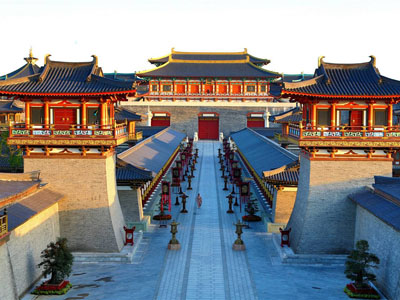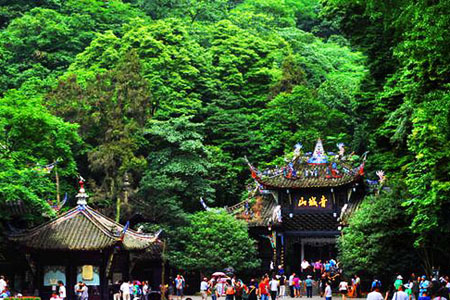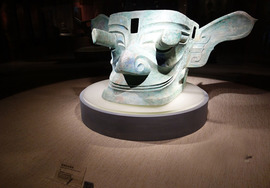The Jiayang steam train has been running for almost half a century in Qianwei County, Leshan City, Sichuan Province. It was in 1958 that the Jiayang Coal Mine (predecessor to the Sichuan Jiayang Group) built the Ba-Shi (Bajiao Valley-Shixi) Railway — a total length of 19.84 kilometers — and bought trains from the Shijiazhuang Steam Engine Locomotive Factory in Hebei Province to solve the problem of coal transportation. It opened on July 12, 1959. The trains were known as “inch gauge” because their gauge is only 76.2 centimeters — half that of the common standard.
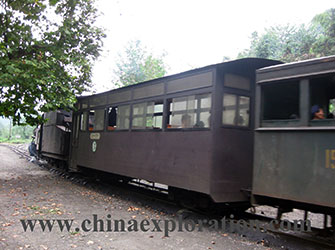
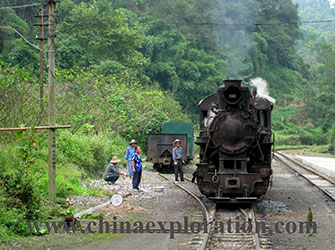
The train got its name from its owner, the Jiayang Group. To transport coal out its mine, Jiayang Coal Mine, the predecessor of Jiayang Group, built a narrow gauge railway line between Bajiaogou and Shixi, which was abbreviated as Bashi Railway, and then purchased locomotives and rolling stock from Shijiazhuang Motive Power Machinery Works. In July 1959 the railway, in 762mm gauge and a total length of 19.84 kilometers, went into operation to haul coal from the mine, as well as being used by the local peasants taking a ride into town. With a size smaller than the standard gauge, the diminutive train began to be literally known in Chinese as the inch-sized train.
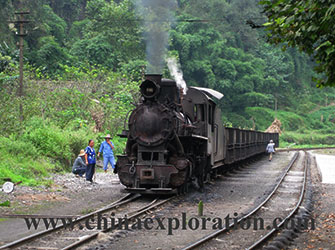
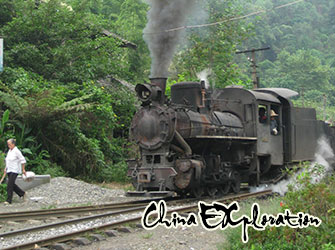
A product of the technology of the first Industrial Revolution, the train contains all the essential elements used in the majority of engines right up until the last ones were built in Britain in the 1960’s. Manually shoveling the coal via the fire-door into the furnace, propelled by the steam – complete with steam-powered whistle – and with small axles on the narrow track, the locomotive turns on Y-turnout track invented by Zhan Tianyou (1861~1919), China’s outstanding rail-way engineer. Signals and phone calls are made by hand as well as switching of tracks. It’s a spectacular sight, especially as the railway line ascends and descends over gradients, some as steep as 36‰, and twists around sharp curves of 70m in radius as well as wide curves, and tunnels galore: the route is as exciting as the train itself.
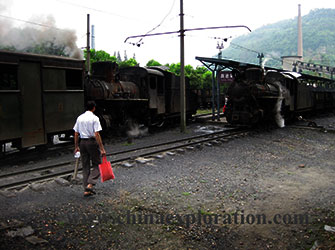
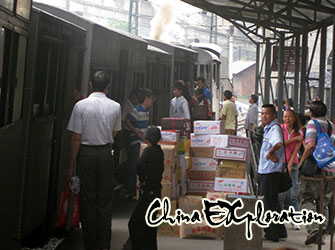
Painted in dark green, the diminutive locomotive is composed of a boiler that generates steam for the driving wheels and a tender that carries coal and water. The train pulls 5 to 8 carriages coupled together but not accessible to each other. Each carriage is less than 5 meters long, with rustic facilities inside and non-glazed windows on the side, which can be however shielded by pulling down the iron sheet. Wooden benches are in place for 20 seated passengers whilst others have to stand. A conductor or conductress is on duty to be responsible for each carriage whilst a chief conductor and a policeman are responsible for the whole train, which drops and collects passengers at 8 stops on the line. The conductor sells the ticket, who also has the responsibility, when the train goes down a slope, to tighten up the hand-brake to aid the engineer in slowing down the train.
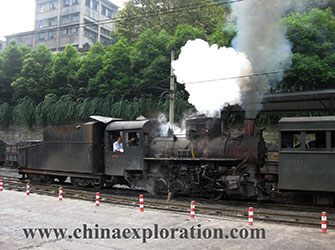
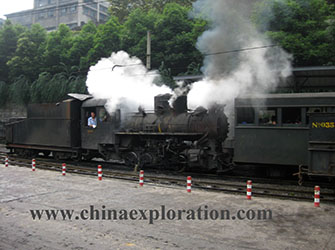
In places like the Shuixingzai (Mercury Village) Canyon, the Bajiaogou (Plantain) Valley, and the Mifeng (Honeybee) Crag, there are typical alpine landforms featured by green mountains and deep canyons. After passing through the valley, there are expanses of graceful, bucolic scenery over low hills, scattered ancient villages dating back to the Qing Dynasty, and the Mabian River densely covered with spinulose trees of the Jurassic period…
The small steam train twists its way on the narrow gauge track, leaving white smoke behind it as if it’s shuttling between the past and the present. Sitting in the jerky, rusted carriage whilst hearing the melodious steam-blown whistle and the thunderous locomotive, passengers feel at the intersection of history and modernity. The wonders of the age-old train bring us back to another era.
According to statistical records, the steam train, ever since 1959 when it started operation, has carried 11 million passengers/times and 19.5 million tons of coal. As it is the sole transportation means connecting the hamlets in the mountains and the outside world, the residents have developed a deep affection for the steam train. A ticket is available at 5 yuan for seated passengers and 3 yuan for standing passengers from all the stops on the line, and the steam train makes 4 runs a day to cover the whole distance to and fro in approximately two and a half hours.
What’s amazing is that the train has maintained a record of punctual departure all year long. Jiayang steam train As steam locomotives are taken out of service over the world, the Jiayang narrow gauge steam train, which is still in operation, has drawn the attention of people from home and abroad. Thanks to the attention paid by the local government, the Jiayang narrow gauge steam train is now running with great vigor and vitality for business. To better preserve this time-honored artifact as one of the earliest products of the Industrial Revolution for our descendants to see and feel, on April 18, 2006 Leshan Municipality put it on the city’s list of Industrial Heritage, and on June 1, 2007 the Sichuan Provincial Government listed the same under provincial-level protection.
As they are the only old-style narrow-gauge steam locomotives still carrying passengers, Jiayang trains have been dubbed “living fossils of the 18th century Industrial Revolution.” Sad to say, before too long these “living fossils” will be put to rest forever.
Jiayang Steam Train Tour Package:
1. 2 Days for Jiayang Steam Train and Leshan Giant Buddha
